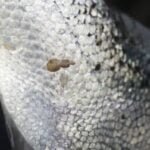by University of Gothenburg
Norwegian salmon farmers introduce wild cleaner fish from remote locations to control salmon parasites in their aquaculture. However, the cleaner fish escape and propagate with local populations. Though implications of this importation are difficult to assess, it poses the risk that the escapees will spread genetic traits that impair the ability of native populations to survive.
The use of cleaner fish to control salmon lice and other parasites in salmon aquaculture has increased exponentially in the last three to four years. Last year Norwegian salmon famers used 54 million cleaner fish. This is portrayed as a more environmentally desirable alternative to traditional pesticides. But in a new thesis, Ellika Faust at the University of Gothenburg points out that using cleaner fish also has risks.
Effects on ecosystem is uncertain
“A large proportion of wild cleaner fish are caught in areas other than the locations of the salmon farms,” says Ellika Faust. “Many cleaner fish escape from the salmon farms and interbreed with the local populations. We do not know for certain how ecosystems are affected by these imports.”
Faust has studied one of the cleaner fish used in salmon farms in Norway in particular, the corkwing wrasse. Many of these corkwing wrasse are caught on the Swedish west coast and the Norwegian south coast and then translocated live to Norwegian salmon farms. DNA analyses show that the populations in Kattegat and Skagerak are the same populations genetically, but that corkwing wrasse from the Norwegian west coast have a different DNA profile and belong to a different population. A genetic barrier between the Norwegian south and west coasts developed about 10,000 years ago.
Not all translocated fish are recorded
To protect marine ecosystems, all incidents when salmon escape from salmon farms are to be reported to the Norwegian authorities. Records are to be kept of all live fish imported from Sweden to Norway by species and where they are stocked. But that does not apply to the cleaner fish caught and translocated within the country. Approximately 20 per cent of all cleaner fish used in salmon farms come from the Norwegian south coast and are part of the Kattegatt-Skagerak population.
“To understand the risks and impacts this can have on the local populations, we need to know how many fish are being moved and to what destination. We do not know that now. Unfortunately, the translocations occurring within Norway are not recorded. This should be easy to fix,” says Faust.
We still do not know the consequences of this large translocation of live fish in the ocean. Corkwing wrasse from Skagerak and Kattegat grow faster than fish from the Norwegian west coast and can adapt to local conditions. Researchers have also noted that the escapees establish themselves further north along the Norwegian coast than where the local populations of the corkwing wrasse are found.
Ongoing experiment
“Now that people have mixed the two populations, it is hard to rewind the tape. This is an ongoing experiment that I would like to look at from a genetic perspective. What genes control the different characteristics of the fish and is there any selection for or against the crossed offspring?”
Stay Always Informed
Join our communities to instantly receive the most important news, reports, and analysis from the aquaculture industry.
Contact
Ellika Faust
Doctoral Student
+46 766-22 90 03
+46 31-786 90 03
ellika.faust@gu.se
Reference
Faust, Ellika. 2022. Crossing barriers: Genetic consequences of translocating wild cleaner fish for aquaculture. Doctoral thesis. University of Gothenburg. Faculty of Science. https://hdl.handle.net/2077/70594
Editor at the digital magazine AquaHoy. He holds a degree in Aquaculture Biology from the National University of Santa (UNS) and a Master’s degree in Science and Innovation Management from the Polytechnic University of Valencia, with postgraduate diplomas in Business Innovation and Innovation Management. He possesses extensive experience in the aquaculture and fisheries sector, having led the Fisheries Innovation Unit of the National Program for Innovation in Fisheries and Aquaculture (PNIPA). He has served as a senior consultant in technology watch, an innovation project formulator and advisor, and a lecturer at UNS. He is a member of the Peruvian College of Biologists and was recognized by the World Aquaculture Society (WAS) in 2016 for his contribution to aquaculture.




